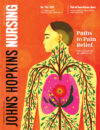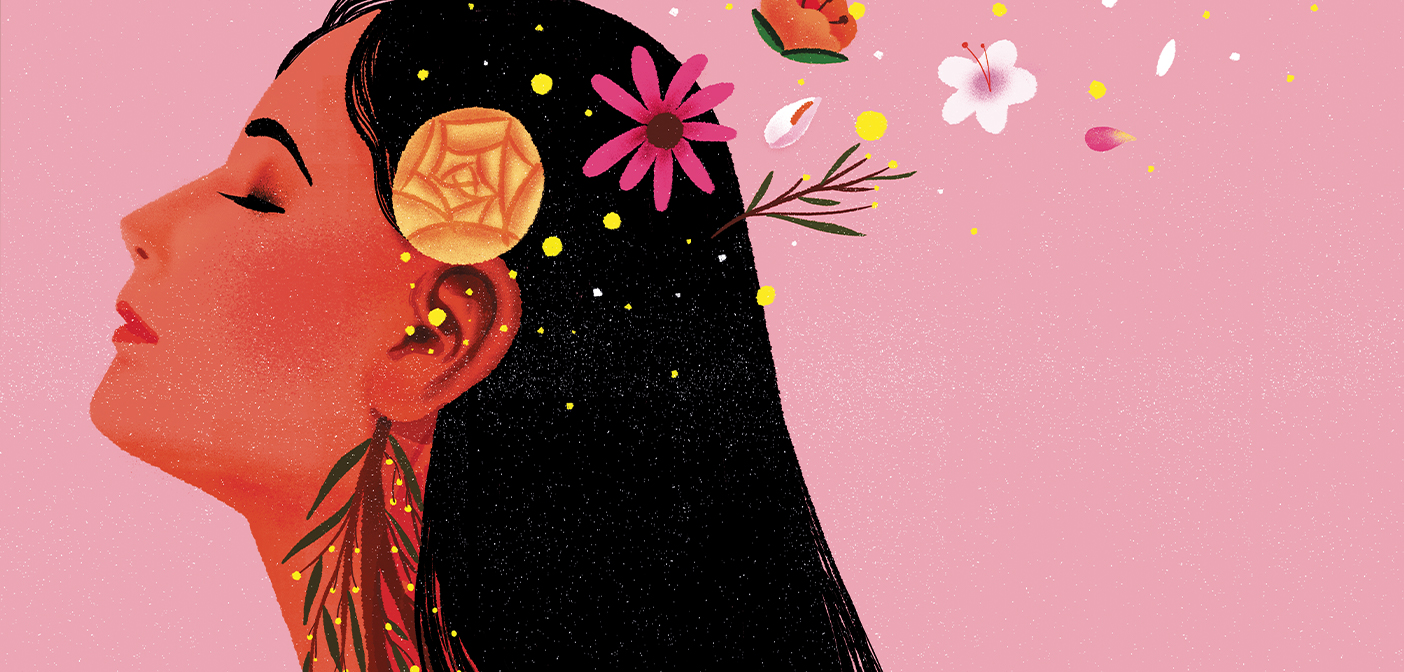U.S. providers have been slow to embrace the practices of Eastern medicine. But researcher Chao Hsing Yeh has helped plant the seed on auricular point acupressure as a non-opioid pain reliever, and it’s taking root.
Written by Steve St. Angelo | Illustrations by Decue Wu
Descriptions of auricular point acupressure might at first feel odd to the Western ear: Put a seed (or other small pellet) against the ear. Press, repeat, get welcome relief. It is far from the first of Eastern medicine’s innovations to be slowly, reluctantly accepted by the Western health industry. But the simple, inexpensive treatment for chronic pain and a variety of cancer symptoms—fatigue, nausea, vomiting—as well as insomnia, depression, and various other ailments is erasing skepticism as it builds promise as an alternative to dangerously addictive opioids and other pharmaceuticals.
The simple, inexpensive treatment for chronic pain is erasing skepticism as it builds promise as an alternative to dangerously addictive opioids.
Associate Professor Chao Hsing Yeh, recipient of the Johnson & Johnson Nurses Innovate Quickfire Challenge award and riding a wave of success in grant funding from the National Institutes of Health and American Cancer Society, recognizes the roadblocks and the doubt but goes with the flow. Her own focus on auricular point acupressure stems from her earlier, sometimes frustrating work with pediatric cancer patients. Many of these children refused the treatment over body image concerns. Having lost their hair, they figured, the now very visible treatment would make them stand apart from peers even more. This despite the relief auricular point acupressure (APA) offered. Yeh felt powerless to help them. “It’s such a big deal, because these kids need to heal, and you can’t sleep because of the pain,” she explains.
Determined to do more, Yeh shifted her research to adults and expanded from chronic pain management to include mood disorders and other ills as APA and methods of implementing the treatment continued to advance. For instance, Yeh is very excited about a smartphone application she has developed that allows patients to incorporate APA into a self-treatment plan to manage pain and improve quality of life. She invented the Auricular Point Stimulation device—a concept similar to transcutaneous electrical nerve stimulation (TENS)—which the app controls via Bluetooth. The phone sends signals on a programmed schedule and the device forwards a pulse to tiny electrodes on the ear, which apply pressure.
History
The idea that energy channels course through the human body is an ancient one, as is the idea that tapping such streams—via acupuncture or others means—could trigger healing bodily responses. History traces this knowledge in part to ancient warfare fought with stones and spears: Survivors of such epic battles, pierced and bruised, often reported that chronic conditions had suddenly eased or disappeared altogether, a result credited to an unblocking of the qi, or life energy, through their wounds.
According to traditional Chinese medicine, the qi is responsible for regulating spiritual, emotional, mental, and physical harmony within the body. This energy moves within invisible channels, or meridians, that connect organs and tissue. Major meridians may touch several systems within the body.
In the 1950s, a French doctor named Paul Nogier turned his research on the body’s response to acupuncture into an easy visual guide to auricular points on the ear. Nogier’s famed chart featured an illustration of an inverted fetus within the outline of an ear to graphically display that lower points on the ear control the head and neck area, for example, with higher points for the hip, knee, or heel.
Eventually his work made its way back to China. From there, researchers and practitioners further developed what was, in essence, a rail map of the human body. (Pleasure impulses have been shown to reach the brain much faster than pain impulses. Thus, if you can flood the brain with a rush of endorphins by stimulating the corresponding ear points, the pain train cannot get down the track.)
Acupuncture works the same way as APA but with specialized needles that make self-treatment a formidable challenge. Though it has steadily gained traction as a pain treatment in the West, the limited number of trained acupuncturists and a lack of insurance reimbursement are significant barriers for Americans hoping to take advantage of the technique. Seeds (or pellets) are considered far less invasive than needles, of course, and offer a great opportunity for self-management. “It is a novel, inexpensive, safe, and non-pharmacological method that can be incorporated in a self-management plan to habitually manage pain,” Yeh says. “It has great potential to improve pain management and reveal a critical pathway to mitigate the opioid epidemic.”
Quick Relief
Skepticism can remain, for 30 seconds or so anyway.
“I thought to myself, ‘What’s that little seed gonna do for me?’ I was very skeptical,” explains Mary Finney, an employee at the School of Nursing who was encouraged to join a study by Yeh on whether acupressure patients could learn to self-apply the seeds, saving a trip to a medical office.
“I thought to myself, ‘What’s that little seed gonna do for me?’ ”
Finney had suffered from debilitating lower-back pain and sciatica for several years, to the point where she had thrown aside her beloved high heels and was even considering a wheelchair. “Sometimes just walking across the street to Johns Hopkins Hospital for an appointment, I’d have to sit down part way there.” She hated popping painkillers but was more frightened by the prospect of surgery, which had been prescribed by an orthopedist. She was desperate. Finney dragged herself and her doubts to see Yeh.
“I couldn’t believe it,” she explains of the treatment. “Dr. Yeh asked me to walk across the room. I could still feel a little twinge, but the pain was like 80 percent gone.” In half a minute. And it hasn’t been back.
It’s not an uncommon response, Yeh reports, explaining that such a study can be considered a success if 30 percent of participants experience positive results. She has been regularly recording positive results in 51 percent to 60 percent of patients. “My participants ask me how they can continue the treatments,” says Yeh, who has pushed her findings about the effectiveness of APA in over 30 peer-reviewed publications.
Brother, Lend Me an Ear
Finney pulls out an acupressure kit that she keeps handy: mainly a short metal probe for easily locating the spots on the ear that trigger a response and a sheet of tear-away, self-adhesive, all-natural vaccaria seeds that Finney buys online. (“It’s really not that hard for you to find the correct points in your ears,” insists Yeh. A how-to video makes it even easier.)
Now a little over a year removed from that first treatment, Finney is a walking testimonial to the benefits of APA. A stroll across campus is no longer a deal- or back-breaker. At a recent family reunion, she pitched the treatment to a sibling who had long suffered lower-back pain much like hers. Then she pulled out her kit. “I loaded him up,” Finney says. Just like that, another believer.
The pharmaceutical giant Glaxo SmithKline has come around as well, having taken note of Yeh’s APS smartphone app and its possibilities for pre- and post-operative care, among many other uses.
Pain Is Essential
Pain is the body’s way of instructing us that something is wrong: Don’t touch hot or sharp things; stop exercising, or you may injure yourself worse. It is also a diagnostic tool for health care providers. “How are you feeling?” can help determine how you are healing. Simply hiding all pain through APA, then, isn’t the idea.
Short-circuiting chronic pain, though, has become a tremendous medical challenge as the population ages, endures more illness (post-chemo neuropathy, Alzheimer’s/dementia, arthritis, etc.), and demands relief, often in the form of opioids. (Chronic pain is among the top reasons people file claims for Social Security Disability Insurance.) This has set in motion a dangerous cycle of addictions and overdoses that killed 69,000 Americans from February 2018 to February 2019, according to the Centers for Disease Control,
and in the end does little to address pain control.
Short-circuiting chronic pain has become a tremendous medical challenge as the population ages, endures more illness, and demands relief, often in the form of opioids.
Yeh and an increasing number of researchers and patients believe the answer lies within these little seeds, ancient Chinese medical theories, a 1950s diagram, and modern innovation via the smartphone. And forget about the little warnings that tend to come with advertising for the latest wonder drug. “There are no side effects,” she says.

